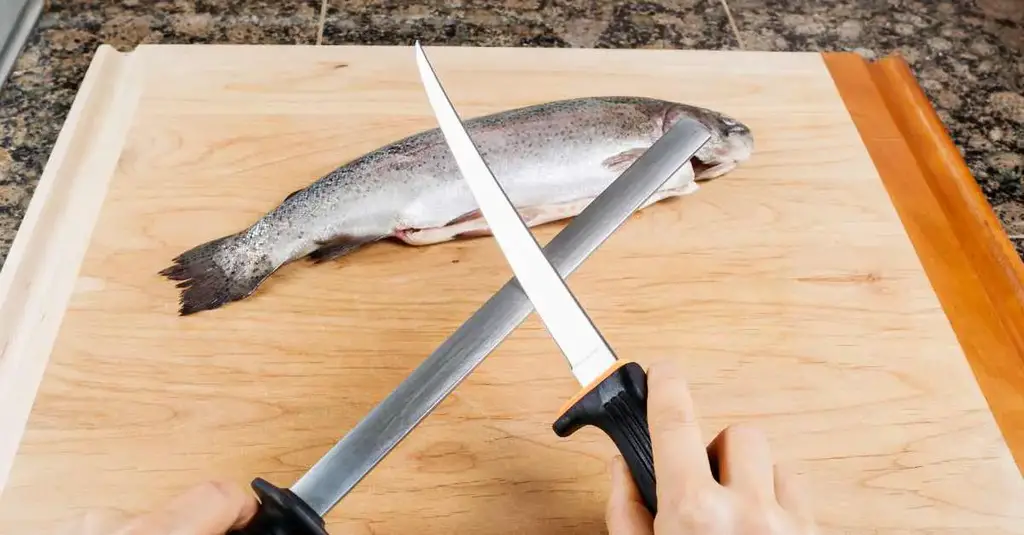Tools are essential in seafood and culinary arts. Fish knives are important cooking tools. Knowing what a fish knife is and how it varies from other knives is crucial for chefs and seafood lovers. This article will cover fish knives’ qualities, applications, and why they’re essential for fishers.
What Is a Fish Knife?
Fish knives cut, prepare, and serve fish. Fish knives are designed to handle delicate fish flesh and slippery surfaces. These knives have thin, flexible blades for precision fish handling.
The Anatomy of a Fish Knife

Explore a fish knife’s anatomy to learn its function. Fish knives have these parts:
Blade: Fish knives have long, thin, flexible blades. This design facilitates precision fish filleting, deboning, and slicing. Depending on the fish knife, the blade is straight or slightly bent.
Handle: Knife grip and control. It’s ergonomically shaped and built of wood, plastic, or composites. Safe and efficient handling requires a pleasant grip, especially when wet.
Bolster: The broad blade-to-handle connection is the bolster. It balances the knife and minimises hand slippage.
Tang: The blade extends into the handle. Full-tang knives are stronger and more balanced since the blade runs through the handle.
Rivet: The rivet secures the handle and tang.
Types of Fish Knives

Fish knives have many uses. Here are some common types:
Fillet Knife
Most fish knives are fillet knives. Its long, thin, flexible blade allows perfect fish filleting. Flexible blades easily separate fish flesh from bones. Fish sizes require varying blade lengths for fillet knives.
Bone Knife
Boning knives are made for fish bones. Its small, pointed blade helps remove bones without injuring tissue. Depending on the fish being deboned and personal choice, the blade might be stiff or flexible.
Sharp Knife
Serrated bread knives can cut through strong fish skin and scales. Slicing without ripping the fish’s delicate flesh is easier with serrations. Serrated fish knives are useful but not necessary.
sashimi knife
Traditional Japanese cuisine uses the sashimi knife. Its long, single-edged blade with a slight concave shape allows perfect sashimi and other raw fish slicing. These blades, manufactured of high-quality steel, need regular sharpening.
Chef Knife
Despite its name, a chef’s knife can be used to prepare fish. Chef’s knives can fillet, debone, and slice fish. It’s versatile for multifunctional knife users.
Choosing the Right Fish Knife

To cook well, choose the correct fish knife. Consider these variables before choosing:
Blade Material
Fish knives are usually stainless or high-carbon steel. High-carbon steel blades are sharper and last longer than stainless steel blades. Choose a material that suits your tastes and budget.
Handles and Grip
Fishing requires a good grip. Look for a comfortable, non-slip handle. Textured or ergonomic handles improve grip and reduce fatigue.
Blade Length
Choose a blade length based on your typical fish size. Larger fish require longer filleting blades. When handling delicate fish or jobs, shorter blades provide more accuracy and control.
How to Use a Fish Knife

Mastering fish knife skills will improve your fish preparation skills. Common uses and methods:
Fish filleting
Starting behind the gills, slide the knife along the backbone parallel to the ribs to fillet a fish. While gliding the knife, gently lift the fillet to separate the flesh from the bones. Smoothly adjust angle and pressure.
Scale Removal
Hold the fish by the tail and scrape the scales from tail to head with the back of the knife blade or a scaler. Remove scales consistently. Scale the fish and rinse to remove loose scales.
Deboning Fish
Debone fish with a boning knife. Make a small incision along the bone and use the knife tip to travel around it. Separate the flesh and bones gently. Slowly remove all bones.
Cut Fish
Use a sharp knife and even pressure to cut fish cleanly. Slice thinly by angling the knife. Make sure your knife is sharp enough to cut sashimi without damaging it.
Maintaining and Caring for Fish Knives

Fish knives last longer with proper care. Try these:
Clean and Wash
Rinse the knife with warm water and mild dish soap after use. Abrasive cleaners and scrubbers might harm the blade. To avoid rust, dry the knife.
Proper Storage
Knife blocks, sheaths, and magnetic strips safeguard fish knives. Avoid putting them in a cluttered drawer where they may damage or dull other cutlery.
Honing and Sharpening
To keep fish knives sharp, sharpen them often. Use a sharpening stone or blade-specific knife sharpener. Before each use, use an honing steel to sharpen the knife.
Fish Knife FAQs
How do fish knives differ from conventional knives?
Fillet, debone, and slice fish with thin, flexible fish knives. Regular kitchen knives have wider, stronger blades.
Fish knives for other meats?
Fish knives are designed for fish, but they can also cut poultry and soft beef. Use a stronger knife for tougher cuts.
Dishwasher-safe fish knives?
Fish knives should be handwashed. Dishwashers harm blades and handles with excessive heat and harsh detergents.
Fish knives for vegetables?
Fish knives can cut vegetables. Their narrow blades and sharpness allow for accurate cuts and delicate vegetable preparation.
Is a sushi knife necessary?
A sharp, well-maintained fish knife can be used to make sushi instead of a sashimi knife. Before handling raw fish, clean, sharpen, and deodorise the blade.
Fish knife sharpening frequency?
Use determines sharpening frequency. Sharpen your fish knife every few months or whenever it cuts poorly.
Conclusion
Fishermen need a fish knife. Whether you’re a chef or a seafood lover, its unusual style and practicality make it a kitchen essential.
You can improve your fish preparation skills by learning about fish knives, picking the perfect one, and using proper practises.
